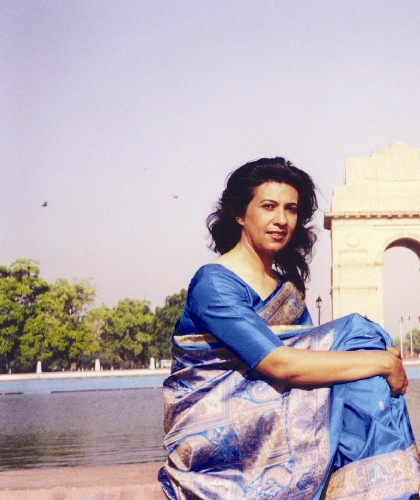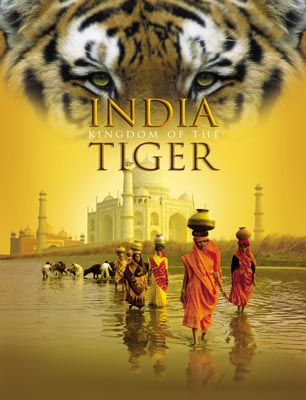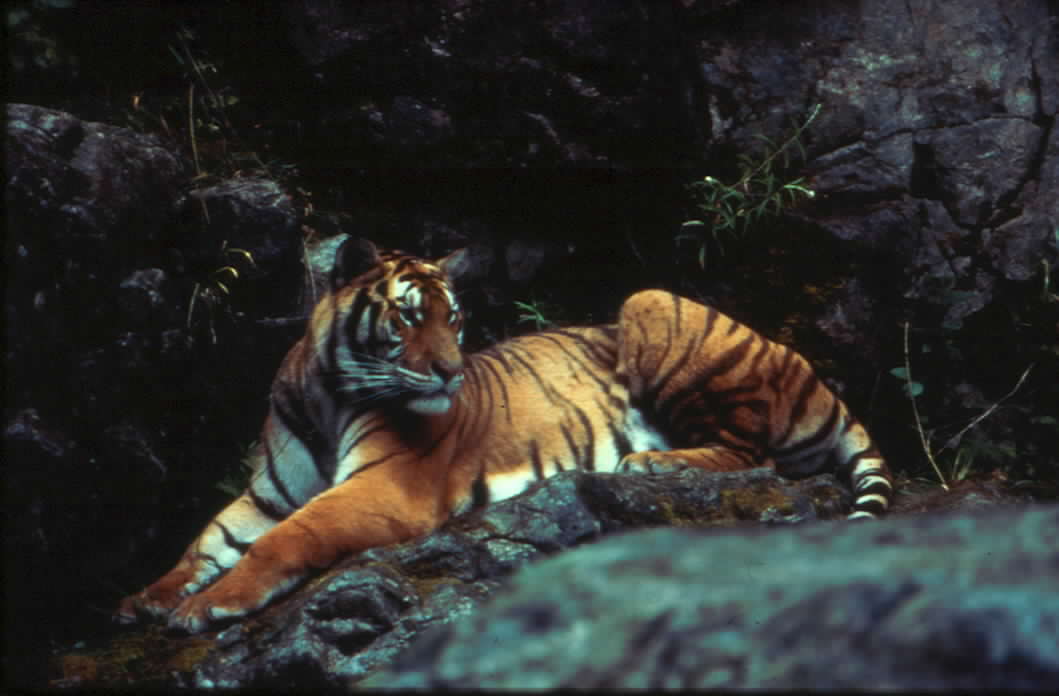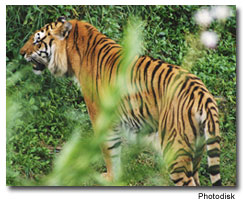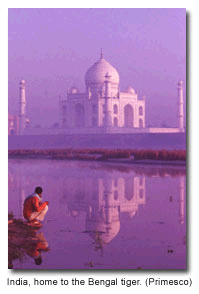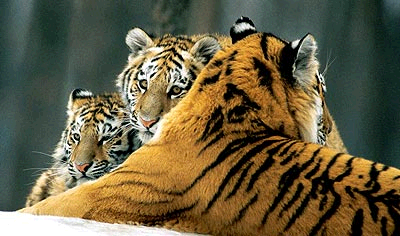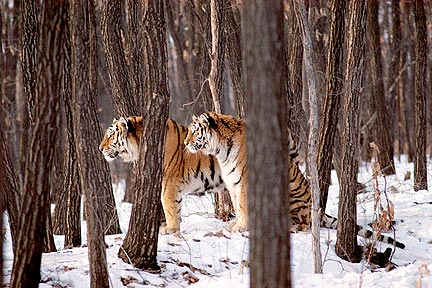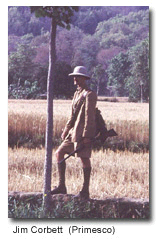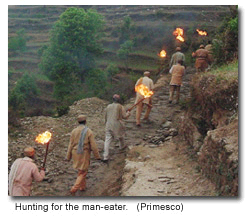Contribute
| Lokvani Talks To Afsana Amarsy, Film Producer |
Chitra Parayath
02/24/2004
Afsana Amarsy had a vision --- and luckily for us her visions are in IMAX format.
When Amarsy visited India for the first time with her children, she was amazed at what she found. She had imagined India’s little villages and quaint lifestyle but was blown away by Mumbai. “I knew then that I had to put this India, of vibrant colors and incredible energy into an IMAX Large format screen”, she said. Born in Madagascar, her ties with India were severed when her grandparents (Gujarati Shiah Ishnashris) left Gujarat over a 100 years ago. The trip was something of a home coming nevertheless.
Afsana Amarsy is the producer of ‘India: Kingdom of the Tiger’, the first ever IMAX film on India.
Born in Africa, raised in London and Paris, schooled at Harvard and currently residing in Montreal, Amarsy is Co-President of Primesco, one of Canada's leading producers and distributors of IMAX films. India: Kingdom of the Tiger is a collaboration between the National Wildlife Federation and Primesco, the Montreal-based company owned by Amarsy and her husband Ghoulam.
Primesco has produced seven Imax films including: Super Speedway; Wolves (produced in partnership with the National Wildlife Federation); Wildfire: Feel the Heat produced with the Discovery Channel; Bears, produced with both the National Wildlife Federation and Science North, Lost Worlds: Life in the Balance, produced with the National Science Foundation and the American Museum of Natural History, and most recently, India-Kingdom of the Tiger, produced in partnership with the National Wildlife Federation.
Said Amarsy “An IMAX film is usually a docudrama and the content is very well researched. Over three years in the making, India - Kingdom of the Tiger saw our production team crisscross the country with tons of equipment and dozens of production personnel, to tell the story of an astonishing land and it's great ambassador to the world, the Bengal Tiger. An IMAX film frame is three times larger than standard 70mm film and can be viewed only in special theatres with huge projectors and screens.”
The Amarsys and their crew arrived in India with great enthusiasm but their equipment took a few days to even retrieve it from Customs. Imagine their surprise when they found that some of their equipment had been dismantled and needed to be reassembled. The Indian Customs Department inspectors had never seen film rolls that big or a camera that weighed one ton, and carried out pretty thorough inspections.
So, how was her experience shooting the first IMAX film in India?
“Crisscrossing the rough and tough terrains with cumbersome equipment, we were often slaves to the weather. Shooting in IMAX technology requires extreme clarity. It is extremely hard to shoot during the Monsoons. If it got too wet or humid, we knew we could not shoot and had to wait till the conditions were more suited. Sometimes it took us days to get necessary permits to go into regions and shoot footage. And when we had all the papers ready, the weather would turn worse. We also faced difficulties transporting our big equipment through small streets and gallis in villages.”
“But In the end, we are very pleased with the film. IMAX films can only be 40 minutes long and editing was particularly hard, I had meters and meters of footage on the cutting floor. But we wanted to make a film that was educational and imaginative. This docudrama has a nice mix of the history of conservation, a travelogue of the country, and footage of tigers in the wild. You see the power, grace, and beauty of these enormous beasts up close and larger-than-life.”
What does she think is most striking about this film?
“The film follows in the footsteps of Jim Corbett, the famed English hunter-naturalist, as he races to save an Indian village from the terror of a man-eating tiger. Along his journey he expresses his passion for tigers and explores the issues of tiger conservation.
How was the film received in India?
“This film has not been screened in India yet. It is currently playing in eight languages in dozens of prestigious theatres worldwide, and everywhere the response has been overwhelmingly positive. Today, we are working with the Canadian government and Indian partners to explore the possibility of developing a large format theatre complex in New Delhi. We hope that India – Kingdom of the Tiger, will be a permanent destination exhibit at this venue.”
What about funding and financing required for such a large undertaking?
“It takes time to get the financing. As these are documentaries, they are picked up by libraries. But IMAX films have no advertising or marketing budget. Mainstream films have tons of money that they spend on advertising but we cannot rely on that.”
As IMAX films get more popularity around the world, is that going to change?
“I don’t think so, there are currently only about 300 IMAX theaters in the world, so it is a small and professional niche. Teenagers and people under the age of thirty still don’t see many IMAX films. If younger people began to watch these large format films, they will get more popular!
Our earlier blockbuster was Super Speedway and now this film on India is also a blockbuster!
It has been already shown in about 28 countries and has been very well received by all.”
And is Afsana familiar with Bollywood films?
“Of course I am”, she laughs.
What next?
“I'm currently in partnership with LIFE Magazine, the Statue of Liberty-Ellis Island Foundation and IMAX Corporation, to produce an IMAX 3D/2D film entitled America, America - a film inspired by the iconic photographs of American life found in the pages of LIFE Magazine.”
Cinematographer, James Niehouse, and Director of Photography, Matt Williams, traveled to Bandhavgarh National Park, in the heart of India to film a family of tigers in the wild. The goal was finding and filming Bacchi, a young tigress and her two cubs. Montrealers Filipe Rui Teixera (assistant camera), Abhish Singh Birla (sound recordist) and K.S. Birla completed the production team.
INDIA – Kingdom Of The Tiger- Review
Originally released in IMAX® theatres, India: Kingdom of the Tiger takes the filmgoer on a journey across India. One comes face to face with the Bengal tiger and the spectacular world this majestic creature inhabits.
Inspired by the writings of Jim Corbett, writer, hunter and conservationist, "India: Kingdom of the Tiger" is a tribute to the animal and its homeland. The 40 minute film is loosely structured around a period in the life of Corbett, who pioneered wildlife conservation in India. Corbett, the son of a British postman, originally gained fame in India as a fearless hunter of man-eating tigers. Corbett soon began to shoot the tigers with his camera instead of a rifle and became a tiger conservationist and a well-loved writer. Now, there is actually a species of Indo-Chinese tiger named after him: Panthera tigris corbetti, and India's first wildlife conservation park was called Corbett National Park in his honor.
India: Kingdom of the Tiger explores the challenges facing the mighty tigers that once roamed India by the thousands. Taking viewers from the majestic Himalayan peaks to the golden deserts of Rajasthan, it explores the timeless spirit of India and the fate of its tiger population. The film also evokes the diverse mélange of Indian atmosphere - a Hindi holy man, elephants, city life, music and the natural chain of life are part of a rhythmic whole. There is nothing revolutionary or particularly surprising about KINGDOM OF THE TIGER - but it is smart and dreamy at the same time.
There was a time when Bengal tigers measuring up to 10 feet in length and weighing 500 pounds would roam the Indian jungle freely. Today, there are less than 3,000 of these animals left in the wild. As India's population began to grow, humans began to encroach on the territory of the tigers and, when the two met, death was almost inevitable. The film seeks to educate viewers about the significance of the Bengal tiger, the land they once claimed as their kingdom and the increasing pressure from encroaching human populations that tigers now face in their struggle to survive in their own native habitat. The film recreates an incident in the life of an Indian village on the edge of a tigers domain. The Jim Corbett character serves to highlight the conflicting choices facing a society that seeks to prosper and grow in a land that they must share with magnificent beasts, who may have been there first. The IMAX film also displays, in super wide-angle, the socio-economic and environmental impacts of ongoing urbanization and industrialization in the environmentally sensitive lands in the subcontinent, which happen to be habitat to many endangered species.
India: Kingdom of the Tiger is a National Wildlife Federation (NWF) presentation of a Primesco production. It stars the critically acclaimed Indian actress Smriti Mishra and Christopher Heyerdahi (playing Jim Corbett).
”India: Kingdom of the Tiger" will show in the Mugar Omni Theater through May 28. Admission costs $8.50 for adults, $7.50 for seniors (60-plus), and $6.50 for children (3 to 11). Combination tickets for exhibit halls and theater admission are available. For information, call (617) 723-2500, (TTY) (617) 589-0417, or visit www.mos.org. The theater is wheelchair accessible.
You may also access this article through our web-site http://www.lokvani.com/
